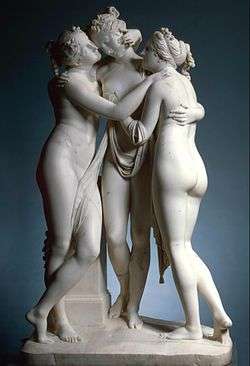Antonio Canova
Antonio Canova (Italian pronunciation: [anˈtɔːnjo kaˈnɔːva]; 1 November 1757 – 13 October 1822) was an Italian Neoclassical sculptor,[2][3] famous for his marble sculptures. Often regarded as the greatest of the Neoclassical artists,[4] his sculpture was inspired by the Baroque and the classical revival, and has been characterised as having avoided the melodramatics of the former, and the cold artificiality of the latter.[5]
Antonio Canova | |
|---|---|
 Self-portrait, 1792 | |
| Born | Antonio Canova 1 November 1757 |
| Died | 13 October 1822 (aged 64) |
| Nationality | Republic of Venice (1757-1798) Austria (territory ceded to Austria) (1798-1805)[1] Kingdom of Italy (1805-1814) Austrian Empire (1814-1822) |
| Known for | Sculpture |
Notable work | |
| Movement | Neoclassicism |
Life
Possagno
In 1757, Antonio Canova was born in the Venetian Republic city of Possagno to Pietro Canova, a stonecutter, and Maria Angela Zardo Fantolini.[6] In 1761, his father died. A year later, his mother remarried. As such, in 1762, he was put into the care of his paternal grandfather Pasino Canova, who was a stonemason, owner of a quarry,[5] and was a "sculptor who specialized in altars with statues and low reliefs in late Baroque style".[6] He led Antonio into the art of sculpting.
Before the age of ten, Canova began making models in clay, and carving marble.[7] Indeed, at the age of nine, he executed two small shrines of Carrara marble, which are still extant.[8] After these works, he appears to have been constantly employed under his grandfather.[8]
Venice
In 1770,[6] he was an apprentice for two years[7] to Giuseppe Bernardi, who was also known as 'Torretto'. Afterwards, he was under the tutelage of Giovanni Ferrari until he began his studies at the Accademia di Belle Arti di Venezia.[6] At the Academy, he won several prizes.[8] During this time, he was given his first workshop within a monastery by some local monks.[7]
The Senator Giovanni Falier commissioned Canova to produce statues of Orpheus and Eurydice for his garden – the Villa Falier at Asolo.[9] The statues were begun in 1775, and both were completed by 1777. The pieces exemplify the late Rococo style.[9][10] On the year of its completion, both works were exhibited for the Feast of the Ascension in Piazza S. Marco.[5] Widely praised, the works won Canova his first renown among the Venetian elite.[6] Another Venetian who is said to have commissioned early works from Canova was the abate Filippo Farsetti, whose collection at Ca' Farsetti on the Grand Canal he frequented.
In 1779, Canova opened his own studio at Calle Del Traghetto at S. Maurizio,.[5] At this time, Procurator Pietro Vettor Pisani commissioned Canova's first marble statue: a depiction of Daedalus and Icarus.[5] The statue inspired great admiration for his work at the annual art fair;[11] Canova was paid for 100 gold zecchini for the completed work.[5] At the base of the statue, Daedalus' tools are scattered about; these tools are also an allusion to Sculpture, of which the statue is a personification.[12] With such an intention, there is suggestion that Daedalus is a portrait of Canova's grandfather Pasino.[11]
Rome
Canova arrived in Rome, on 28 December 1780.[8] Prior to his departure, his friends had applied to the Venetian senate for a pension.[8] Successful in the application, the stipend allotted amounted to three hundred ducats, limited to three years.[8]
While in Rome, Canova spent time studying and sketching the works of Michelangelo.[6]
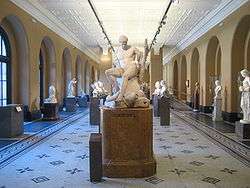
In 1781, Girolamo Zulian – the Venetian ambassador to Rome – hired Canova to sculpt Theseus and the Minotaur.[13] The statue depicts the victorious Theseus seated on the lifeless body of a Minotaur. The initial spectators were certain that the work was a copy of a Greek original, and were shocked to learn it was a contemporary work.[14] The highly regarded work is now in the collection of the Victoria & Albert Museum, in London.[13]
Between 1783–1785, Canova arranged, composed, and designed a funerary monument dedicated to Clement XIV for the Church of Santi Apostoli.[7] After another two years, the work met completion in 1787.[8] The monument secured Canova's reputation as the pre-eminent living artist.[8]
Canova's earliest significant breakthrough was his self-portrait sculpture, finished in 1790.
In 1792, he completed another cenotaph, this time commemorating Clement XIII for St. Peter's Basilica. Canova harmonized its design with the older Baroque funerary monuments in the basilica.[15]
In 1790, he began to work on a funerary monument for Titian, which was eventually abandoned by 1795.[6] During the same year, he increased his activity as a painter.[5]
The following decade was extremely productive,[8] beginning works such as Hercules and Lichas, Cupid and Psyche, Hebe, Tomb of Duchess Maria Christina of Saxony-Teschen, and The Penitent Magdalene.[16]
In 1797, he went to Vienna,[17] but only a year later, in 1798, he returned to Possagno for a year.[8][note 1]
France and England
By 1800, Canova was the most celebrated artist in Europe.[6] He systematically promoted his reputation by publishing engravings of his works and having marble versions of plaster casts made in his workshop.[18] He became so successful that he had acquired patrons from across Europe including France, England, Russia, Poland, Austria and Holland, as well as several members from different royal lineages, and prominent individuals.[5] Among his patrons were Napoleon and his family, for whom Canova produced much work, including several depictions between 1803 and 1809.[4] The most notable representations were that of Napoleon as Mars the Peacemaker, and Venus Victrix which was portrayal of Pauline Bonaparte.
Napoleon as Mars the Peacemaker had its inception after Canova was hired to make a bust of Napoleon in 1802. The statue was begun in 1803, with Napoleon requesting to be shown in a French General's uniform, Canova rejected this, insisting on an allusion to Mars, the Roman god of War.[19] It was completed in 1806.[20] In 1811, the statue arrived in Paris, but not installed; neither was its bronze copy in the Foro Napoleonico in Milan.[19] In 1815, the original went to the Duke of Wellington, after his victory at Waterloo against Napoleon.[20]
If one could make statues by caressing marble, I would say that this statue was formed by wearing out the marble that surrounded it with caresses and kiss
Venus Victrix was originally conceived as a robed and recumbent sculpture of Pauline Borghese in the guise of Diana. Instead, Pauline ordered Canova to make the statue a nude Venus.[21] The work was not intended for public viewing.[21]
Other works for the Napoleon family include, a bust of Napoleon, a statue of Napoleon's mother, and Marie Louise as Concordia.[7]
In 1802, Canova was assigned the post of 'Inspector-General of Antiquities and Fine Art of the Papal State', a position formerly held by Raphael.[5] One of his activities in this capacity was to pioneer the restoration of the Appian Way by restoring the tomb of Servilius Quartus.[22] In 1808 Canova became an associated member of the Royal Institute of the Netherlands.[23]
In 1814, he began his The Three Graces.[7]
In 1815, he was named 'Minister Plenipotentiary of the Pope,'[5] and was tasked with recovering various works of art that were taken to Paris by Napoleon.[8]
The works of Phidias are truly flesh and blood, like beautiful nature itself
— Antonio Canova[5]
Also in 1815, he visited London, and met with Benjamin Haydon. It was after the advice of Canova that the Elgin marbles were acquired by the British Museum, with plaster copies sent to Florence, according to Canova's request.[8]
Returning to Italy
In 1816, Canova returned to Rome with some of the art Napoleon had taken. He was rewarded with several marks of distinction: he was appointed President of the Accademia di San Luca, inscribed into the "Golden Book of Roman Nobles" by the Pope's own hands,[7] and given the title of Marquis of Ischia, alongside an annual pension of 3000 crowns.[8]
In 1819, he commenced and completed his commissioned work Venus Italica as a replacement for the Venus de' Medici.[24]
After his 1814 proposal to build a personified statue of Religion for St. Peter's Basilica was rejected, Canova sought to build his own temple to house it.[6] This project came to be the Tempio Canoviano. Canova designed, financed, and partly built the structure himself.[5] The structure was to be a testament to Canova's piety.[18] The building's design was inspired by combining the Parthenon and the Pantheon together.[5][7] On 11 July 1819, Canova laid the foundation stone dressed in red Papal uniform and decorated with all his medals.[18] It first opened in 1830, and was finally completed in 1836.[18] After the foundation-stone of this edifice had been laid, Canova returned to Rome; but every succeeding autumn he continued to visit Possagno to direct the workmen and encourage them with rewards.[8]
During the period that intervened between commencing operations at Possagno and his death, he executed or finished some of his most striking works. Among these were the group Mars and Venus, the colossal figure of Pius VI, the Pietà, the St John, and a colossal bust of his friend, the Count Cicognara.[8]
In 1820, he made a statue of George Washington for the state of North Carolina.[17] As recommended by Thomas Jefferson, the sculptor used the marble bust of Washington by Giuseppe Ceracchi as a model.[25] It was delivered on 24 December 1821. The statue and the North Carolina State House where it was displayed were later destroyed by fire in 1831. A plaster replica was sent by the king of Italy in 1910, now on view at the North Carolina Museum of History. A marble copy was sculpted by Romano Vio in 1970, now on view in the rotunda of the capitol building.[25][26]
In 1822, he journeyed to Naples, to superintend the construction of wax moulds for an equestrian statue of Ferdinand VII. The adventure was disastrous to his health, but soon became healthy enough to return to Rome. From there, he voyaged to Venice; however, on 13 October 1822, he died there at the age of 64.[8] As he never married, the name became extinct, except through his stepbrothers' lineage of Satori-Canova.[7]
On 12 October 1822, Canova instructed his brother to use his entire estate to complete the Tempio in Possagno.[18]
On 25 October 1822, his body was placed in the Tempio Canoviano.[8] His heart was interred at the Basilica di Santa Maria Gloriosa dei Frari in Venice, and his right hand preserved in a vase at the Accademia di Belle Arti di Venezia.[6][8][18]
His memorial service was so grand that it rivaled the ceremony that the city of Florence held for Michelangelo in 1564.[18]
In 1826, Giovanni Battista Sartori sold Canova's Roman studio and took every plaster model and sculpture to Possagno, where they were installed in the Tempio Canoviano.[18]
Works
Among Canova's most notable works are:
Psyche Revived by Cupid's Kiss (1787)
.jpg)
Psyche Revived by Cupid's Kiss was commissioned in 1787 by Colonel John Campbell.[27] It is regarded as a masterpiece of Neoclassical sculpture, but shows the mythological lovers at a moment of great emotion, characteristic of the emerging movement of Romanticism. It represents the god Cupid in the height of love and tenderness, immediately after awakening the lifeless Psyche with a kiss.
Napoleon as Mars the Peacemaker (1802–1806)
Napoleon as Mars the Peacemaker had its inception after Canova was hired to make a bust of Napoleon in 1802. The statue was begun in 1802, with Napoleon requesting to be shown in a French General's uniform, Canova rejected this, insisting on an allusion to Mars, the Roman god of War.[19] It was completed in 1806.[20] In 1811, the statue arrived in Paris, but not installed; neither was its bronze copy in the Foro Napoleonico in Milan.[19] In 1815, the original went to the Duke of Wellington, after his victory at Waterloo against Napoleon.[20]
Perseus Triumphant (1804–1806)
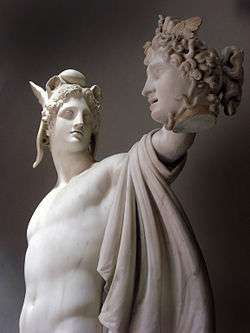
Perseus Triumphant, sometimes called Perseus with the Head of Medusa, was a statue commissioned by tribune Onorato Duveyriez.[28] It depicts the Greek hero Perseus after his victory over the Gorgon Medusa.
The statue was based freely to the Apollo Belvedere and the Medusa Rondanini.[29]
Napoleon, after his 1796 Italian Campaign, took the Apollo Belvedere to Paris. In the statue's absence, Pope Pius VII acquired Canova's Perseus Triumphant and placed the work upon the Apollo's pedestal.[30] The statue was so successful that when the Apollo was returned, Perseus remained as a companion piece.[31]
One replica of the statue was commissioned from Canova by the Polish countess Waleria Tarnowska; it's now displayed in the Metropolitan Museum of Art in New York City.[29][32]
Karl Ludwig Fernow said of the statue that "every eye must rest with pleasure on the beautiful surface, even when the mind finds its hopes of high and pure enjoyment disappointed."[33]
Venus Victrix (1805–1808)
Venus Victrix ranks among the most famous of Canova's works. Originally, Canova wished the depictation to be of a robed Diana, but Pauline Borghese insisted to appear as a nude Venus.[21] The work was not intended for public viewing.[21]
The Three Graces (1814–1817)
John Russell, the 6th Duke of Bedford, commissioned a version of the now famous work.[34] He had previously visited Canova in his studio in Rome in 1814 and had been immensely impressed by a carving of the Graces the sculptor had made for the Empress Josephine. When the Empress died in May of the same year he immediately offered to purchase the completed piece, but was unsuccessful as Josephine's son Eugène claimed it (his son Maximilian brought it to St. Petersburg, where it can now be found in the Hermitage Museum). Undeterred, the Duke commissioned another version for himself.
The sculpting process began in 1814 and was completed in 1817. Finally in 1819 it was installed at the Duke's residence in Woburn Abbey. Canova even made the trip over to England to supervise its installation, choosing for it to be displayed on a pedestal adapted from a marble plinth with a rotating top. This version is now owned jointly by the Victoria and Albert Museum and the National Galleries of Scotland, and is alternately displayed at each.
Artistic process
Canova's system of work concentrated on the initial idea, and on the final carving of the marble[6]
Canova's sculptures fall into three categories: Heroic compositions, compositions of grace, and sepulchral monuments.[8] In each of these, Canova's underlying artistic motivations were to challenge, if not compete, with classical statues.[5]
Canova refused to take in pupils and students,[6] but would hire workers to carve the initial figure from the marble. He had an elaborate system of comparative pointing so that the workers were able to reproduce the plaster form in the selected block of marble.[33] These workers would leave a thin veil over the entire statue so Canova's could focus on the surface of the statue.[33]
While he worked, he had people read to him select literary and historical texts.[6]
Last touch
The polish throws upon the parts which are lighted so great brilliancy as frequently to make invisible the most laborious diligence; it cannot be seen, because the strong reflected light dazzles the eyes
— Johann Joachim Winckelmann[33]
During the last quarter of the eighteenth century, it became fashionable to view art galleries at night by torchlight. Canova was an artist that leapt on the fad and displayed his works of art in his studio by candlelight.[18] As such, Canova would begin to finalize the statue with special tools by candlelight,[6] to soften the transitions between the various parts of the nude.[33] After a little recarving, he began to rub the statue down with pumice stone, sometimes for periods longer than weeks or months.[33] If that was not enough, he would use tripoli (rottenstone) and lead.[33]
He then applied a now unknown chemical-composition of patina onto the flesh of the figure to lighten the skin tone.[6] Importantly, his friends also denied any usage of acids in his process.[7]
Criticisms
Conversations revolving around the justification of art as superfluous usually invoked the name of Canova.[18] Karl Ludwig Fernow believed that Canova was not Kantian enough in his aesthetic, because emphasis seemed to have been placed on agreeableness rather than Beauty.[33] Canova was faulted for creating works that were artificial in complexity.[5]
Legacy
The importance and value of Canova's art is now recognized as holding in balance the last echo of the Ancients and the first symptom of the restless experimentation of the modern age[6]
Canova spent large parts of his fortune helping young students and sending patrons to struggling sculptors,[17] including Sir Richard Westmacott and John Gibson.[35][36]
He was introduced into various orders of chivalry.[7]
The Romantic period artists buried Canova's name soon after he died, but he is slowly being rediscovered.[6]
A number of his works, sketches, and writings are collected in the Sala Canoviana of the Museo Civico of Bassano del Grappa. Other works, including plaster casts are the Museo Canoviano in Asolo.
Literary inspirations
| Wikisource has original text related to this article: |
| Wikisource has original text related to this article: |
Two of Canova's works appear as engravings in Fisher's Drawing Room Scrap Book, 1834, with poetical illustrations by Letitia Elizabeth Landon. These are of The Dancing Girl and Hebe.
Commemorations
- Canova, South Dakota
- Via Antonio Canova, in Treviso
- The Museo Canova in Possagno
- Tempio Canoviano, in Possagno
Gallery
 Antonio Canova from the studio of Canova c. 1813
Antonio Canova from the studio of Canova c. 1813 Tomb of Clement XIII
Tomb of Clement XIII Tomb of Clement XIV
Tomb of Clement XIV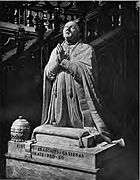 Monument to Pius VI
Monument to Pius VI- Psyche Revived by Cupid's Kiss, Louvre
- Psyche Revived by Cupid's Kiss, Louvre (detail)
 Perseus Triumphant, Vatican
Perseus Triumphant, Vatican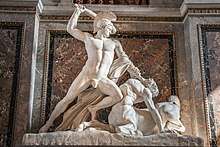 Theseus Fighting the Centaur (1804–1819), Kunsthistorisches Museum, Vienna[note 2]
Theseus Fighting the Centaur (1804–1819), Kunsthistorisches Museum, Vienna[note 2] Pair of portrait busts by Canova, c. 1815
Pair of portrait busts by Canova, c. 1815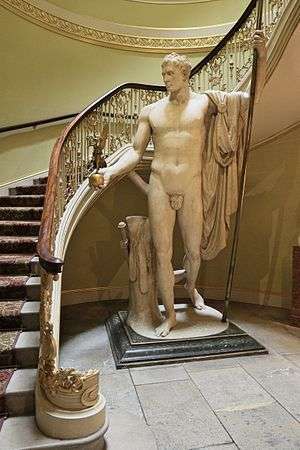
.jpg)
_panoramic_sculpture_Austria_2014_photo_Paolo_Villa_August_FOTO8412_-_FOTO8425auto.jpg) Panorama of Cenotaph to Maria Christina of Austria
Panorama of Cenotaph to Maria Christina of Austria_-_n._2340_-_Tomb_of_Marie_Christine_by_Canova_-_Vienna.jpg) Cenotaph to Maria Christina of Austria in the Augustinerkirche
Cenotaph to Maria Christina of Austria in the Augustinerkirche- The Penitent Magdalene (Palazzo Doria-Tursi, Genoa)
 Antonio Canova Medal by Francesco Putinati
Antonio Canova Medal by Francesco Putinati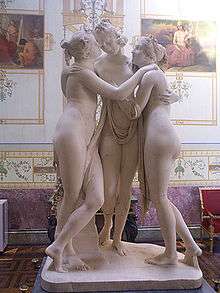 The Three Graces, Hermitage
The Three Graces, Hermitage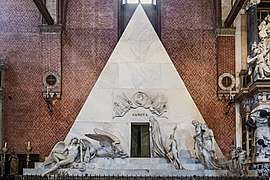
 The bust of Lucrezia D'Este da Antonio Canova[37]
The bust of Lucrezia D'Este da Antonio Canova[37] Venus Italica, ca. 1822–23, Metropolitan Museum of Art
Venus Italica, ca. 1822–23, Metropolitan Museum of Art Terpsichore Lyran (Muse of Lyric Poetry)
Terpsichore Lyran (Muse of Lyric Poetry)- Dancer, 1811-1812, The State Hermitage Museum
Notes
- The Glory of Venice: Art in the Eighteenth Century states (p. 441) that Canova left Venice when it fell, tried to escape to America and then went to Possagno. The fall of Venice was in 1797. There appears to be some gap in knowledge that would correct or amend these accounts. The first reference to Vienna is an online source, the second is the Encyclopædia Britannica, 1911 which has already proven itself incorrect in some areas. The Glory of Venice has proven itself more accurate, but it is undated, leaving speculation of time frame.
- Napoleon ordered it for the Corso in Milan; Emperor Franz I bought it for the Theseus Temple in the Volksgarten in Vienna; moved to Kunsthistorisches Museum in 1891.
References
Citations
- The fall of Venice occurred in 1797 but was then ceded later to Austria. Encyclopedia Britannica - Venice. Accessed 14 May 2018.
- Irwin, David, "Antonio Canova, marchese d'Ischia | Italian sculptor", Britannica.com, retrieved 1 April 2017
- "Canòva, Antonio nell'Enciclopedia Treccani", Treccani.it, retrieved 1 April 2017
- Turner 1996a.
- Jean Martineau & Andrew Robinson, The Glory of Venice: Art in the Eighteenth Century. Yale University Press, 1994. Print.
- Turner 1996b.
- Handley 1913.
- Rossetti 1911, pp. 204–206.
- "Eurydice by CANOVA, Antonio". wga.hu.
- "Orpheus by CANOVA, Antonio". wga.hu.
- "Daedalus and Icarus by CANOVA, Antonio". wga.hu.
- "Daedalus and Icarus by CANOVA, Antonio". wga.hu.
- "Theseus and the Minotaur by CANOVA, Antonio". wga.hu.
- "Antonio Canova: Neoclassical Sculptor, Biography". visual-arts-cork.com.
- "Tomb of Pope Clement XIII by CANOVA, Antonio". wga.hu.
- "Sculptures until 1799". wga.hu.
- "Biography of CANOVA, Antonio in the Web Gallery of Art". wga.hu.
- Oskar Batschmann, The Artist in the Modern World: A Conflict Between Market and Self-Expression. DuMont Bunchverlag, 1997. Print.
- "Napoleon as Mars the Peacemaker by CANOVA, Antonio". wga.hu.
- "Napoleon as Mars the Peacemaker by CANOVA, Antonio". wga.hu.
- "Paolina Borghese as Venus Victrix by CANOVA, Antonio". wga.hu.
- Paris, Rita, “Appia, una questione non risolta" in “La via Appia, il bianco e il nero di un patrimonio italiano.” Electa. 2011
- "A. Canova (1757–1822)". Royal Netherlands Academy of Arts and Sciences. Retrieved 5 October 2016.
- "Venus Italica by CANOVA, Antonio". wga.hu.
- "George Washington Sculpture, North Carolina State Capitol, Raleigh". University of North Carolina.
- "The Canova Statue". North Carolina State University.
- Johns, C.M.S. (1998) Antonio Canova and the Politics of Patronage in Revolutionary and Napoleonic Europe. Berkeley, CA: University of California Press, p. 149.
- "Perseus Triumphant". vatican.va.
- "Antonio Canova: Perseus with the Head of Medusa (67.110.1) – Heilbrunn Timeline of Art History – The Metropolitan Museum of Art". metmuseum.org.
- Christopher M. S. Johns, Antonia Canova and the Politics of Patronage in Revolutionary and Napoleonic Europe. University of California Press, 1998. Web. – p. 25
- "Perseus with the Head of Medusa by CANOVA, Antonio". wga.hu.
- "Perseus with the Head of Medusa by CANOVA, Antonio". wga.hu.
- Satish Padiyar, Chains: David, Canova, and the Fall of the Public Hero in Postrevolutionary France. Pennsylvania State University Press, 2007.
- The Three Graces. Victoria & Albert Museum, 2013. Retrieved 2 May 2013.
- Sicca, Cinzia; Yarrington, Alison (2001). The Lustrous Trade: Material Culture and the History of Sculpture in England and Italy, c. 1700–c. 1860. A&C Black. p. 9. ISBN 9781441185907.
- "John Gibson R. A." www.gibson-trail.uk. Retrieved 8 June 2017.
- "Hôtel des Ventes de Monte-Carlo – MOA auction".
Sources
- Handley, Marie Louise Adelaide (1908), , in Herbermann, Charles (ed.), Catholic Encyclopedia, 3, New York: Robert Appleton Company

- Turner, Jane, ed. (1996a), "Neo-Classical", The Dictionary of Art, Vol. XXII', New York: Grove's Dictionaries.
- Turner, Jane, ed. (1996b), "Antonio Canova", The Dictionary of Art, Vol. XXII, New York: Grove's Dictionaries.
External links
| Wikimedia Commons has media related to Antonio Canova. |

- Canova's Three Graces (second version) in the Victoria and Albert Museum, London (2000). One of three Flickr photos by ketrin 1407.
- Canova's Perseus and Medusa in the Metropolitan Museum of Art, New York (2009). Part of Flickr set by ketrin1407.
- Europe in the age of enlightenment and revolution, a catalog from The Metropolitan Museum of Art Libraries (fully available online as PDF), which contains material on Canova (see index)
- Antonio Canova: Photo Gallery
- Canova's death mask at Princeton
- Canova museum and plaster cast gallery
- Canova 2009 Exhibition in Forlì, Italy
